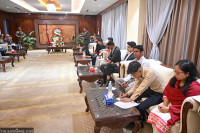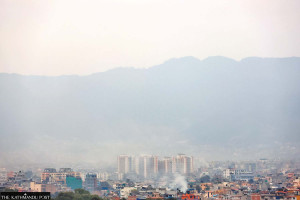Editorial
Higher than before
The new height, which includes the snow height, is 86 centimetres more than the previous measurement..jpg&w=900&height=601)
It's 8848.86 metres—Nepal and China have finally reached an agreement over the exact height of Mt Everest, the world’s tallest mountain that straddles the Nepal-China border. On Tuesday, the two countries resolved the decades-long dispute over whether to take the snow height or the rock height of the world’s tallest mountain. The new height was announced jointly by Foreign Minister Pradeep Gyawali and his Chinese counterpart Wang Yi amid a virtual press conference. The latest measurement has added 86 centimetres to the height of the world’s tallest peak.
The new official height also quells speculations by geologists that the height of Everest could have shrunk and the mountain had moved southwards following the 2015 twin earthquakes. The speculations, in fact, had rekindled the dispute, following which Nepal finally assigned a team for the first time to measure the peak in 2019, dubbing it a ‘national pride’ project which was first envisioned in 2011. But the project soon became an international issue. In October last year, during President Xi Jinping’s state visit to Nepal, officials announced that the two countries would cooperate in resurveying the peak.
Amid the pandemic in May, a year after the Nepali team finished its fieldwork, Chinese surveyors reached the top of Everest to remeasure the peak, following which both teams finally reached a conclusion on the snow-covered height based on the International Height Reference System. The revised elevation which has used both traditional and modern technology is within centimetres of accuracy, according to the Department of Survey. The announcement followed as President Bidya Devi Bhandari and Chinese counterpart Xi Jinping exchanged letters jointly announcing the height, according to Xinhua News Agency.
In his letter, President Xi is quoted as saying the joint announcement is of great significance in carrying forward the undertakings of the predecessors to the future and showcasing the high level of the continuous development of China-Nepal relations. “China is willing to join hands with Nepal to actively promote the cooperation in ecological and environmental protection and scientific research, and better safeguard the precious wealth and home of both peoples,” Xinhua quoted Xi as saying.
While the new elevation following twin surveys by Nepal and China will attract scientific scrutiny in the days ahead, two things stand out. First, the ecological problems in the high altitude ecosystems are fragile and need urgent attention in the wake of unpredictable climatic conditions. Latest research has discovered that tiny, agile dust particles deposited at high altitudes in the Himalaya are contributing significantly to snow darkening more than black carbon, and could speed up snowmelt at a faster rate than previously estimated. An increase in glacial lake expansion is already a major threat for both countries, begging joint efforts in ecological conservation, not just between the two countries, but across the region, which is prone to catastrophes induced by climate change. Now that the dispute around the height of the Everest has been put to rest, it is time for both the neighbours to work towards mitigating effects of human interference on the fragile Himalayas.
Second, China’s growing interest in Nepal’s political matters, its position on the border issues, and its concerns about the sluggish implementation of projects under the Belt and Road Initiative are grabbing international scrutiny. Nepal has long maintained its neutral and non-aligned position in the international arena, and it must follow a pragmatic foreign policy in the fast-changing geopolitical sphere. Given the tight rope we tread on, the leadership has to assess the country’s best interests, given the increasing sensitivities in regional and international relations. Kathmandu has to sincerely pursue high doors in Beijing to ensure that trust, respect and integrity are foundations that partnerships are built on.




 16.12°C Kathmandu
16.12°C Kathmandu














